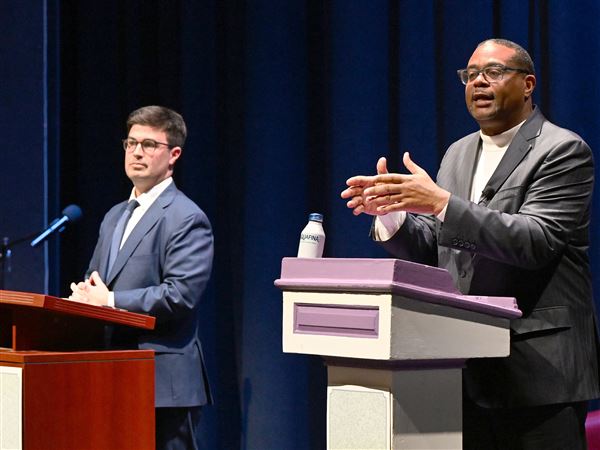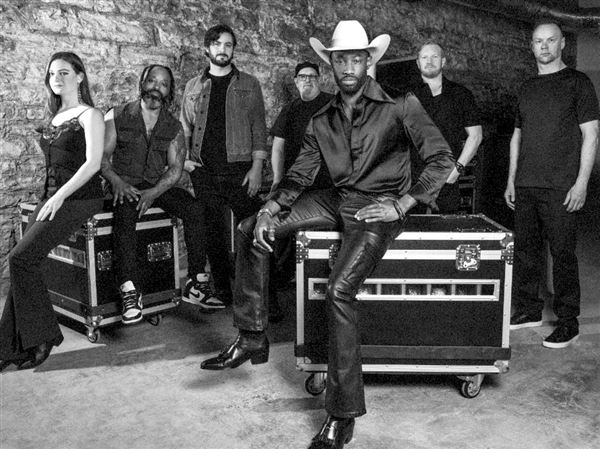His art exhibition was shut down in 1986 by the Communist regime in Bulgaria for displaying "subversive" paintings. But Anastas Konstantinov kept on working, and after the Iron Curtain fell in 1989, he became renowned not just in his own country but in Europe and Japan for his art, which is full of mysticism, symbolism and color.
So what is he doing in Pittsburgh?
For the past three months, the 56-year-old artist and sculptor has been working out of the Ice House Studios in Lawrenceville. On Wednesday, he held an open house of recent paintings that are part of his "U.S. Project," which, his supporters hope, will bring him more recognition in this country.
Mr. Konstantinov was brought to Pittsburgh by Michelangelo Celli, a management consultant who lives in Mt. Lebanon, collects art and discovered Mr. Konstantinov on a business trip to Bulgaria in 2010, when he visited the six-story gallery in the ancient city of Plovdiv.
"I was blown away, deeply moved," said Mr. Celli, who cites Gustav Klimt, Jackson Pollock and Egon Schiele as among his favorite artists. "I said, 'We have to get you here to the U.S.' "
Mr. Konstantinov doesn't speak much English -- he talked mostly through an interpreter -- but he has a strong presence: tall, barrel-chested, a bandana tying back his flowing hair. He is friendly but clearly dead serious about his art, which he describes as a mediation between the material world and the spirit.
Bulgaria boasts some of the most ancient settlements in human history -- Plovdiv, where Mr. Konstantinov grew up, is 7,000 years old and has been an ethnic crossroads on the Balkan Peninsula for just as long, bordering Romania on the north, Greece and Turkey to the south, Serbia and Macedonia to the west. He has always been fascinated by remnants around the region of past civilizations, and when he built his studio in the city's Old Town, it was under the supervision of archaeologists keeping a watchful eye on the multilayered Neolithic, Thracian, Roman and Medieval strata underneath the building.
His roughly textured paintings mingle Eastern mysticism, Western religions, classical mythology, shamans, Christ symbols, Buddhist and Judaic references and, always, a sense of great emotion and love of the natural world. Nothing on the canvas is ever static: There's a sense of constant metamorphosis and change, reflecting his own personal journey as an artist.
In a catalog of Mr. Konstantinov's works, there are two early drawings that reveal a classically trained draftsman -- art schools insisted their students actually learn to draw when Mr. Konstantinov was a youth, he recalled with a laugh. Despite impeccable technique, he abandons realism for abstraction, and during the years under communist rule, his paintings seem violent, nihilistic, ominous, even grotesque.
After 1989, they become more playful but, if anything, more spiritual.
Mr. Konstantinov hasn't been on the radar for most American art collectors -- Christo, the installation artist, is perhaps the only Bulgarian with a worldwide reputation, and he no longer lives there -- but Mr. Konstantinov's work has been purchased by international collectors. His work in Pittsburgh is posted on a website: http://anastasgalleryusa.com/.
He's been surprised over the past three months to discover a city highly hospitable to artists, citing Lawrenceville's rich concentration of studios, performance arts spaces and galleries -- not to mention buildings, bridges and faces that have inspired him.
His fans include the Rev. Drew Morgan, director of the Ryan Catholic Newman Center at the University of Pittsburgh, who, at Wednesday's open house, thumbed through a thick catalog of Mr. Konstantinov's works, pointing to one picture depicting the "Shechina" -- the divine presence of God -- and the Virgin Mary. There's a Judaic symbol in there as well, the Ark of the Covenant.
"There's a tremendous luminosity there," Father Morgan said, noting that Mary -- evoking, in her almond eyes, a Greek or Byzantine icon -- has her hands placed over her heart and womb.
In the Ice House studio, one of the largest paintings is "Mackenzie's Smile," which he recently completed after meeting a little girl on Butler Street by that name. It's all shades of blue, shot through with red and gold -- and one wide, innocent eye.
He's going back to Bulgaria at the end of the month but is already planning a return to the U.S. And while he may seek and find recognition and success elsewhere in this country, there will be, as usual, a Pittsburgh connection.
First Published: July 27, 2012, 8:00 a.m.
















